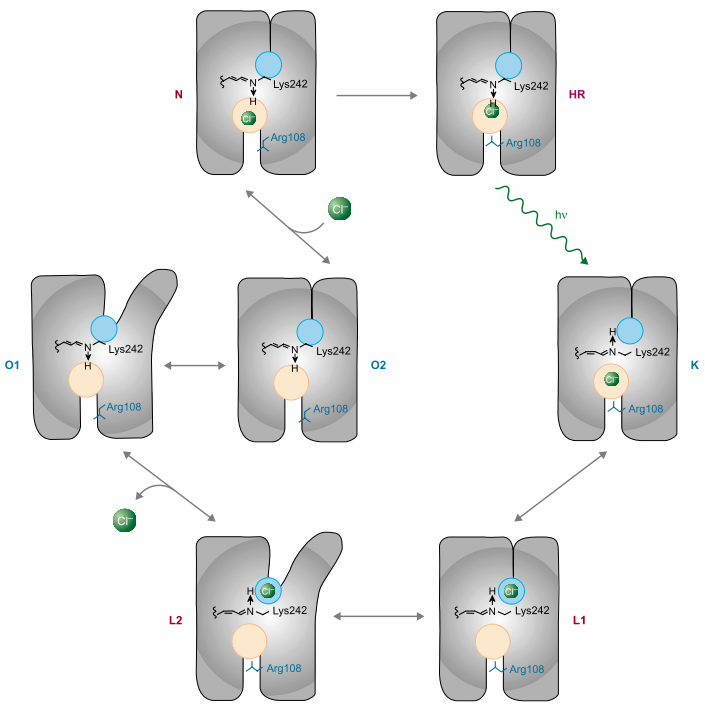Part:BBa_K559000
Halorhodopsin
Halorhodopsin is an inward-directed light-driven chloride ion pump originating from Halobacterium. It utilizes light to pump chloride ions against chloride concentration difference into cells from the environment. Halobacterium is a genus of the Halobacteriaceae, which can live in extremely high salinity environment. Halorhodopsin, together with bacteriorhodopsin, helps maintain cell osmolality and proliferation while reducing the consumption of metabolic energy. It is one of the important features for Halobacterium to live under high salinity conditions 1.
This figure illustrates the molecular mechanism of Halorhodopsin gene on chloride ion absorption, in a controlled manner under light illumination. The whole process can be divided into three stages. Firstly, chloride ion binds to the protonated Schiff base in the Halorhodopsin molecule. Secondly, using the energy of one photon, the ion is transferred to the cytoplasmic half-channel by the bound retinal’s conformational change, the chloride ion is then released to cytoplasm. Finally, the channel changes back to the initial state for the next round of ion transfer 2.
Sequence and Features
- 10COMPATIBLE WITH RFC[10]
- 12COMPATIBLE WITH RFC[12]
- 21INCOMPATIBLE WITH RFC[21]Illegal XhoI site found at 280
- 23COMPATIBLE WITH RFC[23]
- 25INCOMPATIBLE WITH RFC[25]Illegal NgoMIV site found at 292
Illegal AgeI site found at 18 - 1000INCOMPATIBLE WITH RFC[1000]Illegal BsaI site found at 228
Usage and Biology
We have use this biobrick to construct a functional halorhodopsin system unit BBa_K559010
- Halorhodopsin, a light-driven ion pump originated from Halobacterium, employs light to transport chloride ions into cells uni-directionally against osmolality.
- Halorhodopsin has the fascinated property to transform solar energy, the most abundant energy in the world, into intracellular chloride ion level.
1. Lanyi, J.K. Halorhodopsin, a light-driven electrogenic chloride-transport system. Physiological reviews 70, 319(1990).
2. Essen, L.O. Halorhodopsin: light-driven ion pumping madesimple? Current opinion in structural biology 12, 516–522(2002)
//chassis/prokaryote/ecoli
//function/sensor/light
| biology | |
| function | |
| protein |

